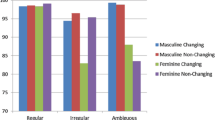Abstract
This paper investigates the difference between the production of grammatical determiners and lexical determiners in the production of adjective-noun phrases (NPs) in Danish. Models of sentence processing (Garrett in Psychology of learning and motivation, Academic press, New York, pp 133–177, 1975; Bock in J Mem Lang 26(2):119–137, 1987) suggest that the phonological encoding stage of grammatical items can only be specified once lexical items have been phonologically encoded. In their usage-based linguistic theory of the grammar-lexicon distinction, Boye and Harder (Lang 88(1):1–44, 2012) propose that this later encoding of grammatical elements is motivated by two specific features of grammatical elements. The first feature, dependence, is that grammatical items (morphemes, words, constructions) cannot be produced in isolation, but are always dependent on a lexical host item. This feature entails a more complex processing which might lead to longer reaction times when comparing the production of NPs with a grammatical determiner to a lexical one. Additionally, a more complex processing might lead to a lower accuracy rate for the grammatical condition relative to the lexical one. The second feature, low prominence, is that grammatical items code background information and therefore cannot convey the main point of a linguistic message. Less focus on grammatical elements might lead to a lower accuracy rate for the production of grammatical elements relative to lexical ones. Those predictions were tested in a task comparing the production of Danish grammatical determiners (indefinite articles) with the production of lexical ones (numerals, which are homonymous with the articles except for a stress difference) in similar contexts. Group-based analyses were performed in order to take inter-individual differences into account. The results show that the two features as proposed by Boye and Harder (2012) are only revealed for the fastest speakers group but not the slower ones.



Similar content being viewed by others
References
Baayen, R. H., Davidson, D. J., & Bates, D. M. (2008). Mixed-effects modeling with crossed random effects for subjects and items. Journal of Memory and Language, 59(4), 390–412.
Baayen, R. H., & Milin, P. (2010). Analyzing reaction times. International Journal of Psychological Research, 3(2), 12–28.
Bates, D. M., & Sarkar, D. (2007). Lmer4: Linear Mixed-Effects Models Using S4 Classes. R package version 0.99875–6.
Bock, K. (1987). An effect of the accessibility of word forms on sentence structures. Journal of Memory and Language, 26(2), 119–137.
Boersma, Paul. (2001). Praat, a system for doing phonetics by computer. Glot International, 5(9/10), 341–345.
Boye, K., & Harder, P. (2012). A usage-based theory of grammatical status and grammaticalization. Language, 88(1), 1–44.
Bradley, D. C., Garrett, M. F., & Zurif, E. B. (1980). Syntactic deficits in Broca’s aphasia. In D. Caplan (Ed.), Biological studies of mental processes (pp. 269–286). Cambridge: MIT Press.
Bürki, A., Sadat, J., Dubarry, A., & Alario, F. (2016). Sequential processing during noun phrase production. Cognition, 146, 90–9.
Garrett, M. F. (1975). The analysis of sentence production. In G. Bower (Ed.), Psychology of learning and motivation (pp. 133–177). New York: Academic press.
Gillespie, M., & Pearlmutter, N. J. (2011). Hierarchy and scope of planning in subject-verb agreement production. Cognition, 118(3), 377–397.
Gordon, B., & Caramazza, A. (1985). Lexical access and frequency sensitivity: Frequency saturation and open/closed class equivalence. Cognition, 21(2), 95–115.
Jaeger, T. F. (2008). Categorical data analysis: Away from ANOVAs (transformation or not) and towards logit mixed models. Journal of Memory and Language, 59(4), 434–446.
King, J. W., & Kutas, M. (1995). Who did what and when? Using word- and clause-level ERPs to monitor working memory usage in reading. Journal of Cognitive Neuroscience, 7(3), 376–395.
Michel Lange, V., & Laganaro, M. (2014). Inter-subject variability modulates phonological advance planning in the production of adjective-noun phrases. Frontiers in Psychology, 5, 43.
Michel Lange, V., Messerschmidt, M., Harder, P., Siebner, R. H., & Boye., K. (2017). Planning and production of grammatical and lexical verbs in multi-word messages. PlosOne. https://doi.org/10.1371/journal.pone.0186685.
Münte, T. F., Wieringa, B. M., Weyerts, H., Szentkuti, A., Matzke, M., & Johannes, S. (2001). Differences in brain potentials to open and closed class words: Class and frequency effects. Neuropsychologia, 39(1), 91–102.
Oldfield, R. C., & Wingfield, A. (1965). Response latencies in naming objects. Quarterly Journal of Experimental Psychology, 4, 272–281.
Peirce, J. W. (2007). PsychoPy—Psychophysics software in Python. Journal of Neuroscience Methods, 162(1–2), 8–13.
R Development Core Team. (2005). R: A language and environment for statistical computing. Vienna, Austria: R Foundation for Statistical Computing. http://www.Rproject.org.
Wagner, V., Jescheniak, J. D., & Schriefers, H. (2010). On the flexibility of grammatical advance planning during sentence production: Effects of cognitive load on multiple lexical access. Journal of Experimental Psychology: Learning, Memory, and Cognition, 36(2), 423.
Acknowledgements
This study was supported by the University of Copenhagen Excellence Programme for Interdisciplinary Research (Project title: “PROGRAM”—Information PROminence and GRAMmar in mind and brain).
Author information
Authors and Affiliations
Corresponding author
Ethics declarations
Conflict of interest
The authors declare that they have no conflict of interest.
Ethical Standards
This work complies with Ethical Standards from Copenhagen University.
Rights and permissions
About this article
Cite this article
Lange, V.M., Messerschmidt, M. & Boye, K. Contrasting Grammatical and Lexical Determiners. J Psycholinguist Res 47, 467–482 (2018). https://doi.org/10.1007/s10936-017-9531-x
Published:
Issue Date:
DOI: https://doi.org/10.1007/s10936-017-9531-x





